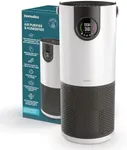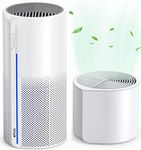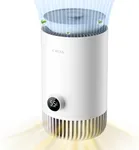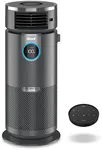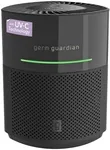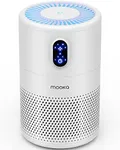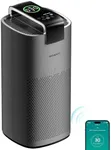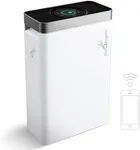Buying Guide for the Best Humidifier Air Purifiers
When choosing a humidifier-air purifier combo, it's important to consider several key specifications to ensure you select the best fit for your needs. These devices not only add moisture to the air but also help to remove pollutants, making your indoor environment healthier and more comfortable. Understanding the key features and how they align with your specific requirements will help you make an informed decision.Coverage AreaCoverage area refers to the maximum size of the room that the humidifier-air purifier can effectively serve. This is important because using a device that is too small for your space will not provide the desired results, while an oversized unit may be unnecessarily expensive and consume more energy. Coverage areas are typically measured in square feet. For small rooms (up to 200 sq ft), a compact unit will suffice. Medium rooms (200-400 sq ft) require a mid-sized unit, while large rooms (over 400 sq ft) need a high-capacity model. Choose a device that matches the size of the room where you plan to use it most frequently.
Filtration SystemThe filtration system in a humidifier-air purifier determines how effectively it can remove pollutants from the air. This is crucial for improving air quality, especially for individuals with allergies or respiratory issues. Common types of filters include HEPA (High-Efficiency Particulate Air) filters, activated carbon filters, and UV-C light filters. HEPA filters are excellent for capturing small particles like dust, pollen, and pet dander. Activated carbon filters are effective at removing odors and chemical vapors. UV-C light filters can kill bacteria and viruses. Consider your specific needs, such as allergy relief or odor control, when choosing the filtration system.
Humidification CapacityHumidification capacity indicates how much moisture the device can add to the air within a certain period, usually measured in gallons per day. This is important for maintaining a comfortable humidity level, which can alleviate dry skin, throat irritation, and other issues caused by dry air. For small rooms, a capacity of 1-2 gallons per day is typically sufficient. Medium rooms may require 2-4 gallons per day, while large rooms might need 4-6 gallons per day or more. Choose a capacity that matches the dryness level of your environment and the size of the room.
Noise LevelNoise level refers to how loud the device operates, usually measured in decibels (dB). This is important if you plan to use the humidifier-air purifier in a bedroom, office, or other quiet space. Lower noise levels (below 30 dB) are ideal for bedrooms and nurseries, as they are whisper-quiet. Moderate noise levels (30-50 dB) are suitable for living rooms and offices, where some background noise is acceptable. Higher noise levels (above 50 dB) may be too loud for quiet environments but could be acceptable in larger, noisier areas. Consider where you will use the device and choose a noise level that will not disrupt your activities.
Maintenance RequirementsMaintenance requirements include how often you need to clean the device and replace filters. This is important for ensuring the device continues to operate efficiently and effectively. Some models have washable filters, which can be more cost-effective but require regular cleaning. Others use disposable filters that need to be replaced periodically. Check the manufacturer's recommendations for cleaning and filter replacement intervals. If you prefer low-maintenance options, look for models with longer-lasting filters and easy-to-clean components. Consider your willingness and ability to perform regular maintenance when making your choice.
Additional FeaturesAdditional features can enhance the functionality and convenience of your humidifier-air purifier. These may include things like a built-in humidistat to automatically maintain desired humidity levels, a timer for scheduled operation, remote control, multiple fan speeds, and air quality sensors. These features can make the device more user-friendly and efficient. Think about which additional features would be most beneficial for your lifestyle and needs. For example, a built-in humidistat is useful for maintaining consistent humidity without manual adjustments, while a timer can help you save energy by running the device only when needed.
